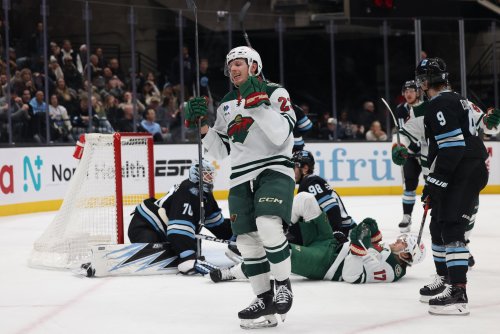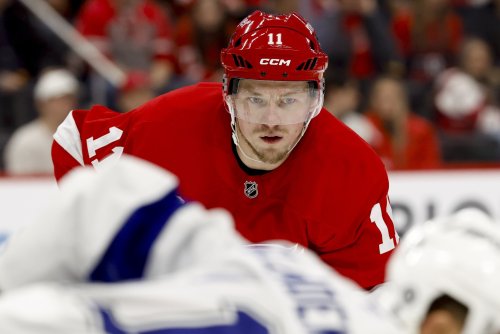
Chuck Fletcher has done it again.
The Minnesota Wild general manager loves to load up at the trade deadline. He did it in 2013, adding Jason Pominville for a package of picks and prospects. He gambled in 2014, swapping two second-rounders for Matt Moulson. And he struck again in 2015, swinging a last-minute deal to add Chris Stewart to the fold.
And last night, in preparation for a Stanley Cup run, Fletcher made another swing for the fences. He acquired Martin Hanzal* for a package that includes Minnesota’s 2017 first-rounder, their 2018 second-rounder, along with a conditional second-round pick in 2019.
It was a hefty price to pay, and the initial reaction from the league (and Minnesota’s fan base) was not too kind for the Wild’s big trade. It’s an understandable reaction for Wild fans to be wary of ponying up for a deadline deal. After all, none of those aforementioned trades amounted to much of anything in the postseason.
Minnesota was swept in the playoffs the year they traded for Pominville. Moulson couldn’t find the scoresheet in the postseason, leading to his being healthy scratched as Chicago eliminated the Wild. Stewart suffered an identical fate the next season.
So yeah. Fans in St. Paul have been burned by this stuff before.
Though a week ago, I probably wouldn’t have been on board with this trade, I’m cautiously optimistic about it now. Am I just talking myself into digging this move? Probably! But still, I think there’s a reasonable case to be made that this move wasn’t only justifiable, but also good. Smart, even.
Let’s work this out together.
The first thing that we need to understand is that Martin Hanzal makes Minnesota a better team than they were Sunday morning. Hanzal keeps Charlie Coyle playing at wing, where most would say he belongs. He also pushes the large (and largely invisible) Tyler Graovac off the roster, which is good.
Some may have reservations about slotting Hanzal into Erik Haula’s place on the third line. But while Haula has performed admirably in his role, Hanzal is a clear upgrade.
Their scoring over the last three seasons has been a wash, but Hanzal separates himself from Haula in his ability to drive play. When Hanzal has been on the ice for Arizona, the Coyotes fared about 3% better in Corsi For% than they did without him. As for Haula, his impact in the shot attempt battle has been negligible.
Hanzal can also slot up in the lineup and take second line duty, if need be. He can be effective with 18+ minutes per night, and he plays both special teams. All things that Haula hasn’t really done throughout his career.
This isn’t to speak poorly of Haula at all. His speed and scoring will no doubt be valuable to the Wild this spring. But the Wild should be much better with him manning the fourth line to make room for Hanzal.
So, the Wild are better having added a Top-9 center. That’s great. But did it have to be Hanzal, who is solid, but admittedly unspectacular?
Yeah. It kinda did have to be him.
Minnesota didn’t really have many options to add a center via trade. Looking at the pending UFA market, the only other center who has A) performed decently this season and B) was a trade candidate is Brian Boyle. And while Boyle may well command a first-round pick himself, he’d cost less than Hanzal for a reason. He’s not as good.
Not nearly as good, really.
That might sound weird to say, seeing as Boyle has 22 points- just 4 fewer than Hanzal, despite Hanzal notching almost 5 more minutes of ice time per night. But it’s true.
Boyle has clearly been in a better situation this season. The Tampa Bay Lightning have struggled without Steven Stamkos, but Boyle’s been somewhat of a beneficiary of that injury. Boyle’s most common linemates this season are Valtteri Filppula and (more notably) Jonathan Drouin, one of the more incredible playmakers in the league. 11 of Boyle’s 16 5-on-5 points have come with Filppula on the ice.
Even more eyebrow-raising, 9 of those points came when playing with the Victor Hedman/Anton Stralman pairing. Boyle’s points per 60 minutes is at an elite 2.83 with Hedman on the ice. Without him? A pathetic 1.07. Credit to Boyle for stepping up when playing with talent, but it appears he’s being lifted by his teammates, not the other way around.
And when you look past this season, it’s not even close. Analytics pioneer Dawson Springins (@DTMAboutHeart) created a Wins Above Replacement (WAR) statistic that attempts to evaluate a player’s overall impact compared to the average freely available (or, replacement-level) player.
You can dig into the methodology on Hockey Graphs, but examining Boyle and Hanzal with WAR shows that Hanzal is far and away the superior player. Over the past 3 seasons, Boyle averaged -1.13 wins over replacement. The amount of penalties he took put his team at a huge disadvantage, and he didn’t make up for that in any other aspect of his game.
On the other hand, here’s how Hanzal has fared:
Hanzal has shown himself to make a positive impact for the Coyotes. He’s averaged 0.92 wins above replacement the past three years, with an injury-shortened season artificially suppressing that number. When healthy, Hanzal’s solidly in the Top 30% of NHL players, which is definitely worth acquiring. Furthermore, you can see that he provides value on both sides of the puck and on special teams.
Now, if you prorate that to somewhere between 30-45 games (counting the rest of the season and a playoff run), a half-win or so may not seem like much. And it probably isn’t. It may not ultimately make a difference. But bringing in a player that’s solidly-above average is definitely an upgrade over using a below replacement-level player like Boyle or Graovac.
So, Hanzal’s worth getting, but that price... Yeesh. It’s hard to blame anyone for thinking the package of picks Minnesota gave up is incredibly steep for a solid rental player.
But don’t focus on how much Hanzal cost. Focus on what Minnesota gave up.
Think about it: A player like Matt Duchene is more talented than Hanzal, and more worthy of spending a ton of assets to acquire.
But acquiring a player like Duchene would certainly take away from your roster. You’d have to lose defensemen depth- probably with either Jonas Brodin or Matt Dumba. You’d probably need to throw in a forward to make the salary cap work. And you’d probably need to part with a prospect, too. Heck, with the seller’s market going on at the trade deadline, maybe you’d give up your first-rounder, too.
Getting a Duchene? That’d be great! But in order to do that, Minnesota would be making themselves weaker in other aspects.
That didn’t happen when the Wild traded for Hanzal. They added to their current roster without taking anything of value away. Their forward depth is better- particularly down the middle- and their blue line remains strong. They didn’t even have to give up one of their blue-chip prospects to swing this deal, which may go a long way into explaining why the package of picks headed to Glendale was so extravagant.
That’s not to say that this trade is perfect. Minnesota recovered somewhat from previous deadline deals by hitting home runs in the draft, but it’s hard to keep up that success with so few picks. Sacrificing as many as 3 high draft choices won’t help them down the road. Losing this year’s first-round pick also gives Fletcher much less leverage to dictate exactly how Vegas pillages the Wild in the expansion draft.
But ultimately, this deal will be judged by the results. If Hanzal becomes a critical part of bringing a Stanley Cup to St. Paul, it’ll be considered a great move, no matter what else happens in the future.
And if not?
Well, Fletcher will have done it again.
*And also Ryan White, who is fairly immaterial, along with a 4th-round pick. Speaking of immaterial, Grayson Downing will head from Iowa to Tuscon to play for the Coyotes’ AHL team.
Huge thanks to Luke Solberg (@EvolvingWild) for his help in finding and providing WAR data.
Think you could write a story like this? Hockey Wilderness wants you to develop your voice, find an audience, and we'll pay you to do it. Just fill out this form.








Recommended Comments
There are no comments to display.
Join the conversation
You can post now and register later. If you have an account, sign in now to post with your account.
Note: Your post will require moderator approval before it will be visible.